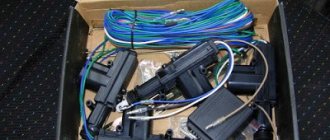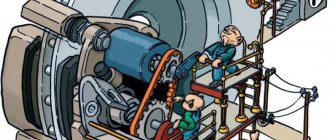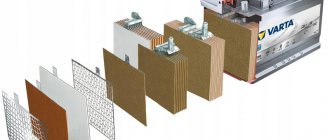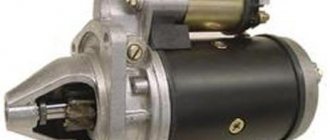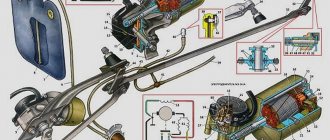Purpose and functions of the alarm
A car alarm cannot be called a specific device. It would be more correct to say that this is a complex of devices consisting of different sensors and control elements and representing a single system.
In Russia there is an approved frequency for all alarms - 433.92 MHz. But many manufacturers on the market produce systems with different frequencies from 434.16 MHz to 1900 MHz (GSM - band for mobile communications).
Anti-theft systems perform several main functions:
- warn of intrusion into the vehicle interior with sound and light signals;
- warn of an attempt of external influence and suspicious approach to a car in a parking lot (removal of wheels, evacuation, impact, etc.);
- notify the driver of intrusion and track the further location of the car (if this function is available).
Various anti-theft systems have their own configuration and functions - from basic to advanced. In simple systems, only the signal function (siren, flashing headlights) is often implemented. But modern security systems are usually not limited to this function.
The composition of a car alarm depends on its complexity and configuration, but in general terms it looks like this:
- Control block;
- various types of sensors (sensors for door opening, tilt, shock, motion, pressure, light and others);
- signal receiver (antenna) from the key fob;
- signaling devices (siren, light indication, etc.);
- control key fob.
Alarm elements layout diagram
All anti-theft systems can be divided into two types: factory (standard) alarm and optionally installed.
The factory alarm system is installed by the manufacturer and is already included in the basic configuration of the car. As a rule, the standard system does not have a variety of functions and is limited only to a warning about hacking.
A wide variety of additional functions can be implemented in the installed systems. It depends on the model and cost.
How to choose the best car alarm
Retail outlets provide a large number of car alarm models with different prices, so you don’t have to pay a high price to choose the best one.
All anti-theft devices are divided into classes, based on which the following categories can be distinguished:
- With an immobilizer. These devices stop the engine, making it impossible for the thief to start the car. Many manufacturers include immobilizers in a regular alarm kit;
- with CAN buses. Thanks to the bus, the security system can be integrated into the overall machine control system. This detail does not affect the protected properties, only the installation of the system;
- With motion blocker. This includes special relay immobilizers. When the alarm is triggered, the electrical supply circuit is broken, which stops the supply of fuel to the engine;
- With GPS module. Such devices are capable of transmitting a signal about the location of the car to the key fob and to the owner’s smartphone. This is convenient because if the car is stolen, the owner can send the location data to the police and it will be quickly found;
- With starting the engine from a distance. Car alarm systems with auto start are recognized as the most modern, because in addition to their main function, these devices can warm up the car and for this you do not have to go outside, especially in winter this is convenient. Also, a running engine will attract the attention of pedestrians and other drivers when attempting to steal;
- With different notification methods. According to this parameter, the alarm is divided into one-way and two-way models. The first ones are not connected to the car owner and can only scare away the thief with a sound signal. In addition to the usual signal, double-sided products provide information to the key fob. The distance can be up to 2000 m.
Alarm systems for vehicles with feedback are recognized as the best, so it is recommended to choose just such products.
Design and principle of operation of the alarm system
All elements of any alarm can be divided into three types:
- actuators;
- reading devices (sensors);
- Control block.
The alarm is turned on and off (arming) using the control key fob. In standard systems, alarm control is combined with central locking control and is implemented in one device together with the ignition key. It also contains the immobilizer tag. However, these are completely different systems and operate independently of each other.
The radio receiver (antenna) receives the signal from the key fob. It can be static and dynamic. Static signals have a permanent encryption code and are therefore susceptible to interception and hacking. At the moment they are almost never used. With dynamic encoding, the packets of transmitted data are constantly changing, creating high protection against interception. The principle of a random number generator is used.
The next development of dynamic is conversational coding. Communication between the key fob and the receiver is carried out via a two-way channel. In other words, the “friend or foe” function is implemented.
A variety of sensors are classified as input devices. They analyze changes in various parameters (pressure, tilt, impact, light, movement, etc.) and send information to the control unit. In turn, the unit activates actuators (siren, beacons, flashing headlights).
Car alarm components diagram
Shock sensor
This is a small sensor that picks up mechanical vibrations of the body and converts them into an electrical signal. The piezoelectric plate produces an electrical signal. Triggering occurs at a certain level of vibration. Sensors are installed around the perimeter of the car body. Shock sensors can often trigger false alarms. The cause may be hail, strong sound vibrations (thunderstorm, wind), or a blow to the tires. Adjusting the sensitivity may help solve the problem.
Tilt sensor
The sensor reacts to unnatural tilt of the car. For example, this could be lifting the car with a jack to remove the wheels. It will also work when towing a car. The sensor does not respond to wind tilt, vehicle position on the ground, or different tire pressures. This is achieved by adjusting the sensitivity.
Motion Sensor
These types of sensors are common in various fields (turning on lights when moving, perimeter security, etc.). When the alarm is on, the sensor reacts to extraneous movement in the cabin and near the car. Dangerous proximity or movement will trigger the siren. Ultrasonic sensors and volume sensors work on the same principle. All of them detect various changes in the volume of the car interior.
Door or hood sensor
Often built-in door limit switches are used as sensors. If you open the door or hood, the circuit will close and the siren will sound.
Features of car alarm installation
A step such as installing an alarm system is quite responsible. Before you begin installation, you need to know about possible nuances in order to avoid repairs and financial costs. To install this equipment you need to have certain skills and abilities, but this is not enough. Today, a huge selection of anti-theft systems from various brands is offered, and there are also various connection schemes. What should you choose? This is really the problem. Among the most famous companies, it is worth highlighting Tomahawk, Sheriff, Mongoose, Panther. Particular attention must be paid to the choice of installation scheme, since the color marking of different devices can be intended for completely different functions.
When installing an alarm system, one of the main documents to follow is the diagram
If you made the alarm yourself, then during the process of connecting it, it is important to clearly understand which wire needs to be connected and where. When connecting security devices with a GSM module at home, it is important to know what this device is intended for, how to connect it correctly and program the system after installation. There may be other actions that you need to be prepared for. If you are not confident in your abilities, then it is better to turn to the services of specialists. Yes, you will have to pay a certain amount, but you will be able to avoid problems.
Basically, the alarm system is installed independently because:
- the car owner likes to do it himself;
- there are financial problems.
Tools and materials
To install the equipment yourself, you will need the following list of materials and tools:
- alarm kit with instructions;
- electronic multimeter;
- additional wires;
- foam rubber (the control unit is wrapped in it);
- black electrical tape with double-sided tape;
- socket wrench, lighter, wire cutter, shaped screwdriver.
After you have prepared everything you need, you can begin installing the device. We’ll talk further about how to do this correctly and where to install it.
How to determine the location of the device in the car
Let's first consider the place where the control unit is installed. Basically, this is the cavity behind the instrument panel. Before installing the block, it is wrapped in foam rubber and tested to see how convenient the location will be. It is important that the fixation is comfortable and that the block does not interfere with anything. To install the anti-theft device correctly, you must follow a few simple recommendations:
- The control unit must be located inside the cabin and in such a place that if an intruder breaks in, it will take as long as possible to get to it. The location where the block will be located is easy to calculate, but getting to it will require time.
- Rubbing elements and parts, for example, rods, cables, etc. should not be located near the block.
- The unit should not be installed near a heating system or a source of high moisture (air conditioning or heater ducts).
- It is necessary to avoid installing the unit in close proximity to antenna cables, mobile phones, and radio stations.
- The bulk of the connections will be made to the devices on the panel.
The control unit is installed in a hidden and convenient place inside the car.
During the installation process, attention should be paid to the following nuances:
- Location of wires in places of bends (door-body). To avoid kinks and fractures of the wiring as a result of constant mechanical stress, it is necessary to use special rubber feed-through tubes, as well as bushings that must have a certain bending radius.
- The door solenoids are mounted away from the pull button that opens the door.
- It is necessary to lay wiring along the body only in places where there is no moisture. For fastening, plastic ties (clamps) are used, the size of which depends on the thickness of the wiring.
These are the main preparatory points that should be taken into account when independently installing the equipment in question. We will consider the detailed connection of the anti-theft system below.
Step-by-step instructions for installing an alarm system
First, it’s worth talking about connections, since experts have differing opinions on this matter. The wires can be connected either by soldering, crimping or twisting. There is an opinion that soldering in a car is unacceptable. Be that as it may, the electrical connections must be reliable and well insulated, for which electrical tape and heat-shrinkable tubing are used.
The ground wire is connected first; it is usually black. It is advisable that the connection point be a standard ground bolt. To do this, a terminal is crimped onto the end of the wire, which must match the size of the bolt. It is unacceptable to connect the ground wire using a self-tapping screw, which is due to the low reliability of the connection. If the mass is connected in the engine compartment, then the connection point is treated with an anti-corrosion agent.
The ground wire of the car alarm is connected to the standard ground bolt, for which a terminal of the appropriate size is crimped onto the end of the wire
The equipment is connected to +12 V with red wires. During the installation process it is important to consider:
- the power is connected to the standard car wiring to wires with a cross-section of at least 6 mm or directly to the battery;
- if a connection is made to a standard wire, then you must take into account the rating of the standard fuse for this circuit;
- It is recommended to connect the relay unit and the alarm unit to different circuits, which are protected by different fuses;
- If you connect the “+” wire to the battery, then it is recommended to install a 30 A fuse in the circuit and place it as close as possible to the positive terminal of the battery. The purpose of this element is additional protection.
Light signaling
The connection is made to the main headlights (low beam) or turn signals. When installing to turn signals, you need to find those wires that come from the turn signal. In the case of headlights, the connection is made with the wire going to the light control relay.
central locking
To connect to the central locking system, you can use different schemes, the choice of which depends on the design of the alarm. The central locking system is located inside the car, in a place where it is not so easy to find. To search, you need to use the electrical diagram of your car. They are connected to this device in the central locking control unit. It can be located in one of the following places:
- on the driver's door;
- on the central dashboard;
- It is possible to install a central locking control button in the cabin.
The alarm system is connected to the central locking control unit in the central locking control unit. To find this block, you need to use the electrical diagram for the car
There are also cars that simply do not have central locking. In this case, you will need to install it.
Limit switches
To connect limit switches (limit switches) on the trunk lid and hood, you will need to find wires related to standard devices and connect to them. Another option is to install additional wires that come with the equipment. The limit switches are installed in such a way that they close at the moment of opening. For installation, special brackets are used. The sensor for the hood is installed on the engine panel; in the luggage compartment it is mounted near the side parcel shelf. To connect the device to the door contacts, determine the connection point in accordance with the electrical diagram for the car.
Limit switches must be installed in such a way that when the hood or trunk is opened, the contacts of the element are closed
Sound alarm and sensors
The siren and sensors are also installed according to the diagram. Its location is chosen in the engine compartment and secured with a bolt. It is possible to mount the sound device under the wiper mount. To do this, it is disassembled and the siren wires are laid together with the wires for the wipers. After installing the sound alarm, the mount is put back together.
Regarding impact sensors, it should be noted that their installation to the body must be as rigid as possible in order for the sensitivity to be the best. Avoid installing elements near air ducts, since the anti-theft device may be triggered by air flow. In addition, it is necessary to exclude direct sunlight to avoid heating. Fastening is done using self-tapping screws. The installation location can be the inside of the wing from the passenger compartment, the area behind the hand brake.
An audible alarm (siren) is installed in the engine compartment and secured with a bolt connection
How to adjust the shock sensor?
The sensitivity of the system in question depends on how correctly the sensor is adjusted. Adjustment is carried out by rotating special screws, thereby decreasing or increasing the level of sensitivity. The required level is selected experimentally by tapping on the car body or wheel. If the sensitivity level is too high, the alarm will be triggered even by the wind. In such a situation, the unit will need to be reprogrammed.
Installation of relay contact group
The connection is made to the fuel pump control system. If there is an illegal entry into the car, the relay is activated, which prevents the fuel pump from starting. In this case, the engine simply will not start.
Glass closers
To ensure that the windows close automatically when the car is armed, devices called closers are used. They are a small unit, the installation of which does not cause difficulties. The connection is made according to the attached diagram. The device is located in the cavity of the driver's door. This is justified by the fact that the main control is carried out by the driver, and the location of all buttons should be nearby. After installing the control unit in the door, there is no need to stretch additional wires and take them out. It is advisable to install the unit as close as possible to the panel with the power window control buttons.
To automatically close windows when arming, glass closers are used, which are mounted in the cavity of the driver's door.
LED and Valet button
Additionally, it is worth mentioning the location of the LED, which indicates that the vehicle is armed and disarmed. Basically, the element is installed in the side pillar (left) of the windshield. If the device includes a Valet service button, then where its location is chosen by the car owner. It is advisable to use inconspicuous places. This button is intended to turn off the siren if the key fob breaks down or is discharged, as well as to program the alarm and emergency shutdown if it is not possible to turn it off in the standard way.
An LED indicator indicating that the vehicle has been disarmed and armed is installed in most cases in the windshield pillar, but other installation locations are also possible
Additional alarm functions
In addition to the main security function, some useful additions can be implemented in car alarms. For example, such as:
- Remote engine start. The engine warm-up function is especially convenient in winter. You can start the engine remotely and prepare it for the trip in time.
- Remote control of power windows. The windows are automatically raised when the car is armed with an alarm system. No need to remember if all the windows are closed.
- Car protection when the engine is running. This function is useful when leaving the car for a short time.
- Satellite tracking (GPS/GLONASS). Many anti-theft systems are equipped with active tracking systems via GPS or GLONASS satellite systems. This is an additional level of protection for the car.
- Engine blocking. Advanced versions of security systems can be equipped with a remote engine stop system. Additional vehicle security against theft.
- Control the alarm and other functions from your smartphone. Modern systems allow you to control all functions from your mobile phone. The availability of this option depends on the configuration and model of the alarm. Management occurs through a special application.
Safety
After arming the car, the car alarm is constantly ready to respond to an external signal received from the sensors. The most obvious function is to respond to sound or impact on the car ; the built-in sensor is responsible for it. If sufficiently strong irritation occurs, the alarm will send a notification to the key fob via its own communication channel, start the engine compartment siren and start signaling with the car's lighting equipment.
The next line of security is protection against entry into the car through opening the doors or trunk . To read the status of the lock and the state of the doors, as we noted earlier, the alarm is connected to a connector switch or CAN bus. Thanks to this, it can monitor most vehicle systems and also trigger an alarm mode in the event of emergency situations.
Even if intruders get inside the car and try to start it, then we still have one more ace up our sleeve - blocking the car's systems . The most common blockage is monitoring the operation of the car’s fuel pump. While the alarm is in alarm mode, it will not allow the fuel pump to function normally, as a result of which the car simply will not start . This effect is achieved by “inserting” the alarm wiring into the standard circuit. You can come up with a wide variety of locks, and their options are limited only by the imagination of the master.
But what if attackers are able to open the hood and remove the terminal from the battery ? Then the alarm will not function? Not certainly in that way. Most modern car alarms have a backup power line on which you can hang an additional battery . It will connect only when contact with the main battery is lost, and will support the operation of the alarm and siren.
But is it possible to turn off the siren? Yes, the siren is powered by a simple wire, it can be cut, but the alarm will not stop blocking the car's systems ; it will still take a lot of time to completely turn it off.
What if the car is simply loaded onto a tow truck ? This situation is also foreseen. Pandora alarms can be equipped with a GPS antenna , which will monitor the location of the car. If it starts moving in security mode, it will be regarded as an emergency situation, and the owner will receive a notification on the key fob or smartphone.
The difference between a car alarm and an immobilizer
Car alarms and immobilizers have similar security functions, but several significant differences. These two concepts are often confused, so some clarity is needed.
A car alarm is a whole security complex that warns the owner about theft or an attempt to break into the car. There are also many other features such as satellite tracking, auto start, etc.
The immobilizer is also an effective anti-theft system, but its functions are limited to blocking the engine from starting if you try to start the car with an unregistered key. The device reads the access code from the chip (tag) in the key and recognizes the owner. If the thief tries to start the car, it will not work. The engine will not start. As a rule, an immobilizer is standardly installed in all modern car models.
The immobilizer will not protect the car from breaking and entering in a parking lot. It only protects against car theft. Therefore, they cannot do it alone. We need a full-fledged car alarm.
Daily use
Using the alarm is very simple. You have a keychain , and optionally a tag . The key fob has buttons (“Remove”, “Put on”, “Service”) and a small screen. The mark is a small plastic thin rectangle, inside of which there is a circuit. If the alarm is configured correctly, the car will not start, or even open, if the alarm does not sense a mark within a radius of 5-10 meters from the car.
If the alarm is triggered, the key fob will begin to make sounds and vibrate, and additional information will appear on the screen.
Many Pandora alarms support GSM channel operation . This means that a SIM card is installed inside the alarm unit, and when an alarm is triggered, an automatic call will be made to the car owner’s phone. The GSM module also allows you to use the Pandora Online mobile application , in which you can monitor all the parameters of the car, disarm it or start it remotely, all without leaving the couch.
Major alarm manufacturers
Model of a security complex from the StarLine company
There are several companies on the market that have proven themselves well and their products are in demand.
- StarLine. The company is one of the leaders in the production of security systems. It produces not only budget models, but also fifth-generation models. The cost varies from 7,000 to 14,000 rubles.
- Pandora. Popular Russian manufacturer of security systems. Wide range of models. Prices range from 5,000 to 48,000 for new advanced models.
- "Scher-Khan". Manufacturer – South Korea, developer – Russia. The cost is in the range of 7-8 thousand rubles. Connection via mobile phone and Bluetooth is possible.
- "Alligator" American security system. Cost up to 11 thousand rubles. Diverse model range.
- "Sherriff". Manufacturer – Taiwan. Budget models are presented, costing 7-9 thousand rubles.
- "Black Bug" Russian manufacturer. The lineup includes both budget and premium models.
- "Ghost" Russian manufacturer of alarm systems with a wide range of models. Prices range from 6,000 to 27,000 thousand rubles.
A car alarm helps protect your car from theft and burglary. Modern security systems provide a fairly high degree of protection. The driver also has many other useful features. An alarm system is a necessary and mandatory thing for every car.
Two-way communication
A car alarm with two-way (feedback) communication allows you to inform the car owner about everything that is happening near the car. This happens due to a reliable connection between the alarm itself and the key fob, which is located with the driver along with the keys. Most often, information is displayed on a small key fob screen or signals danger with a characteristic sound signal and flashing special indicators.
Feedback alarms operate according to three main algorithms: • signal transmission via mobile communications; • coding: - interactive; - dynamic.
How does an alarm work and what should you add to your car?
No one seems to be under any illusion that a steering wheel lock or ignition switch is an effective deterrent to car thieves. The main obstacle for a lover of other people's property is the appearance of protection against breaking the door, breaking the steering lock and turning off the ignition. The thief made a hundred manipulations, the starter works, but the engine does not want to rotate.
Fuel does not flow from the tank, the ignition system does not work, and the computer that controls its operation is completely thinking about something of its own. The operation of all anti-theft devices is similar: when we turn them on, they disable at least one of the elements necessary for driving. In theory, only an authorized person can disable this protection.
A transmission lock, like other mechanical security measures, is only a deterrent for some thieves. Professionals are capable of stealing a car in which both the gearbox and clutch are locked.
Medium set (medium level of protection)
It is recommended to supplement the anti-theft system with a hood lock and an immobilizer.
These two devices “cover” each other according to the principle of mutual responsibility - the hood lock prevents access to the immobilizer, and the immobilizer blocks the engine and prevents unauthorized opening of the hood. The immobilizer and alarm system can interact in different ways. The most advanced models can “communicate” with each other via a wireless encrypted communication channel, making it even more difficult to track the position of the immobilizer. However, the most commonly used immobilizers are those that are controlled by a wired alarm.
The hood lock communicates with the immobilizer via a wire and receives opening/closing signals from it. The absence of a direct connection between the hood lock and the alarm system provides a higher level of security, since an attacker will not be able to open the hood even if the alarm head unit is removed.
